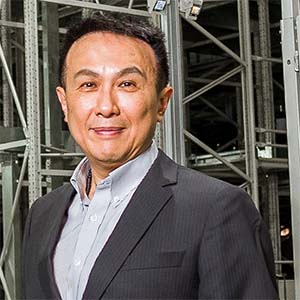Over the past 18 months, the IT channel has arguably faced one of its most difficult periods ever as the Covid-19 pandemic ushered in global restrictions which not only led to curbed business conditions, but other nightmare scenarios such as massive component shortages and severe supply chain disruptions.
This precarious situation was further compounded in South Africa in July when mass riots and their inevitable looting sprees shocked the country.
So how has the channel dealt with the various challenges thrown at it? And what strategies are they adopting going forward? Some of the country’s leading distributors give us their view on the current state of the nation within the local channel.
A resilient channel
Throughout the decades since its formation, the IT distribution channel in South Africa has proved itself to be one of the most resilient sectors in the industry – and the last 18 months have proved to be no exception.
 Pierre Spies, CEO of the country’s largest distribution group, Alviva1, has spent almost all of his working life in distribution and probably epitomises the cautious optimism that is ingrained in it no matter the challenges.
Pierre Spies, CEO of the country’s largest distribution group, Alviva1, has spent almost all of his working life in distribution and probably epitomises the cautious optimism that is ingrained in it no matter the challenges.
“Yes, the market remains tough,” Spies says, “but the IT industry has been quite fortunate in that initiatives like work from home (WFH) and home-schooling continue to drive demand. There has been a bit of a lag on larger infrastructure and software upgrades, but all indications are that activity levels in these areas are increasing.
“We have not waivered from our strategies as a group and we are quietly optimistic that the market will return to its heydays,” he adds. “It might still take a little while, but IT remains key to just about any business’s success.”
Spies acknowledges that many resellers have struggled during the Covid-19 pandemic and its subsequent disruptions, but believes there is light at the end of the tunnel.
“I know there are some resellers who are taking severe strain under the current conditions, but I would encourage them not to concede if at all possible,” Spies says. “A major concern remains the continued component shortages we are faced with and there are varied views on when we will see the end of this. But the demand for IT remains strong and the IT industry is still a good one to be part of.”
 Gary Pickford, CCO: distribution at Tarsus Distribution, says distributors and resellers alike have had to adapt to new ways of doing business.
Gary Pickford, CCO: distribution at Tarsus Distribution, says distributors and resellers alike have had to adapt to new ways of doing business.
“The tech channel is resilient … for now,” Pickford says. “With the supply constraints affecting all our suppliers in one way or the other, we had to adjust by encouraging our resellers to cross-sell and switch-sell across our range – so when we had a shortage of supply in a particular brand, we made a plan and supplied an alternative model or brand. This has assisted us and our partners in maintaining a decent level of turnover, which we are grateful for.
“Logistically, we were proud of how robust our logistical supply chain remained during the rioting in July,” Pickford continues. “Our courier and freight partners went above and beyond to restore services, particularly in the Kwazulu-Natal region.
Looking to the future, Pickford says he is cautious.
“Going forward into the early part of 2022, I am concerned that the current high demand for technology products like PC notebooks and printers, driven by the shift to online education and the hybrid work from home and at the office requirement, is going to slow down in the early part of next year,” he says. “I am also concerned that the fundamental slowdown in our economic growth is going to clamp down on disposable income and corporate budgets.
“This is a big concern for us,” he says, adding that the company is already taking steps to alleviate possible problems.
“To prepare for this and ensure that our reseller partners have ongoing sustainable revenue streams, Tarsus Distribution is introducing a structured partner programme that focuses on pairing our resellers with the thousands of small to medium business CEO’s in the country to help form more long-term partnerships that focus on all aspects of the business technology relationship, not just the supply of tech products.
“Examples of this would include issues such as hybrid compute, security, connectivity and modern print,” Pickford explains. “It is a more holistic approach to provide a ‘solution’ for the SMB CEO that we believe will drive ongoing engagement and revenue generation for our partners.”
 Tim Humphreys-Davies, CEO of Pinnacle, echoes the sentiments of his fellow channel executives.
Tim Humphreys-Davies, CEO of Pinnacle, echoes the sentiments of his fellow channel executives.
“Since we went into lockdown in March last year, life and the workplace has moved to a new norm,” Humphreys-Davies says. “There have been many ebbs and flows, stresses and relief, but one thing we have seen is that change is constant.
“The channel and distribution have had to be very dynamic and fluid to meet the challenges of this constant change and I think, on an overall basis, channel resellers have shown amazing agility to react and take advantage of those opportunities that have presented themselves during this period,” he says. “Many resellers and end users have been very receptive to new brands as shortages of supply have forced a rethink, so we have seen brands such as Proline, Mecer and Asus grow share over this period.
“We have also seen resellers adapt to the needs of managing a pandemic with a move to providing life safety products such as X-Ray machines, heat sensitive cameras and similar products.
“At Pinnacle itself, we have faced the same challenges that every other distributor has faced: supply chain issues, shortages, the inability to meet with vendors and resellers face to face, and mental health issues,” he says. “On a more personal note, I am proud of how the whole of Pinnacle has reacted to these challenges. We have been very fortunate to be able to build a tighter, more family-orientated culture during this time as adversity seemed to bring us closer together. What struck me, and really resonated with me, was how the staff looked out for each other during the hard lockdown. And when some staff members did contract Covid, it was really heartening to see how everyone banded together to help – from dropping off food to providing moral support. I am sure we all experienced this in our industry.
“I’m also proud that under the extremely trying conditions of the pandemic our culture and ability to react timeously remained intact,” Humphreys-Davies continues. “Our service levels had to be maintained during this time and we all took the approach that the pandemic was not going to allow us to drop these service levels.
“I really hope that our resellers felt this, although they must have had huge frustrations with all the delays that shortages, supply chain issues, looting and cyberattacks caused,” he adds. “We also tried to improve our efficiencies during this time by building a full end-to-end e-commerce system which we launched in July 2020. We have seen a pleasing uptake in the use of this service, particularly on the software side of things.”
Humphreys-Davies is another who is optimistic about what the coming months may hold in store for the channel.
“Notwithstanding the challenges that we have all faced, demand still remains strong and we can continue to capitalise on this as an ecosystem,” he says. “Corporate spend continues to be directed towards IT and home demand remains robust.
“At Pinnacle we are continuing to invest in infrastructure, new systems and initiatives that cater for this demand,” he adds. “Fundamental shifts in the way we work and interact with each other have changed forever, in my opinion, and this has created a new depth of demand. I also believe that IT creates its own demand naturally – the more prevalent IT is in your workplace and home, the more you need to manage it. Higher levels of usage demand more storage, more software to help manage and protect this information, for example.”
 Hein Engelbrecht, MD of Mustek, says that the current global processor shortage is arguably the biggest challenge facing the industry and the channel.
Hein Engelbrecht, MD of Mustek, says that the current global processor shortage is arguably the biggest challenge facing the industry and the channel.
“Surging demand, international tensions and the complicated process of building new chip factories are forcing tech buyers to change tack,” Engelbrecht says. “The well-documented global chip shortage that drained 2020/2021 supply is not likely to abate any time soon and the once ‘boring’ semiconductor world is now the centre of attention in the tech world.
“Everyone has woken up to the realisation that practically every product we use contains a semiconductor of some kind and that there really is not enough manufacturing capacity to produce them all,” he adds.
“To make matters worse, there have been sanctions between the US and China which have further drained global supplies. Factor in a pandemic and its related boom in tech sales, plus the increase in computing needs for remote collaboration, and the strain on the global semiconductor pot is increased.
“But while humanity needs more chips, the manufacturing capacity is struggling to keep up,” Engelbrecht says. “Increasing supply is not a simple undertaking. Chip manufacturing facilities not only require billions in investment, but can also take about two years to construct.”
Englebrecht says availability problems and price increases leave distributors and buyers with several options, none of which are ideal but which have to be considered until the chip manufacturing industry overcomes its problems.
“Distributors have been forced to diversify their supplier base, forced to plan better and, when stock is available, buy significantly more,” he explains. “Creating strategic alliances between distributors, manufacturers, resellers and traders helps significantly with finding the small volume of components that are available. Also, diversifying offerings – branching out into cloud-based software models/licences/software as a service which can be offered as a stand-alone or bundled offering with hardware purchases.
“While the chip shortage is a tremendous challenge, it is also forcing purchasers to relook at processes and relationships,” he says. “Price is no longer the determining factor – product availability is. Customers are having to procure product that is fit for purpose and taking what they can get rather than what they ideally want. Fulfilment is an absolute priority, and a lot of up-selling and down-selling is being experienced. This challenge has been exacerbated by an increased demand for products.
“The risk of overhang in the market is something to consider; resellers are potentially placing orders with multiple distributors to minimise risk and try to secure supply,” he says.
In looking at the future – and not just in distribution – Engelbrecht says that digitisation will be a key element.
“It is clear that as a result of the pandemic, the area of opportunity for a large number of companies – especially not digitised or with little innovative production processes – continues to be the implementation of technological resources that allow them to respond to the demands of the current crisis, both at the level of infrastructure and human capital.
“In this sense, the training of work teams through digital means is a need that companies did not consider essential before the coronavirus, and that has become a priority to increase their capacity for adaptation and resilience,” Engelbrecht says. “Without a doubt, the capacities of adaptation, learning, innovation and recovery are emerging as the backbone for the survival of companies during and after the pandemic. Companies that embrace and strengthen these qualities will be able to meet the challenges of economic recovery with greater ease and leadership.
“In the face of all the significant digital technological advancements taking place across the industry, it is important to remember that logistics is ultimately about people and will continue to be so,” he continues. “The nature of jobs will change in all industry verticals, including warehouses and distribution centres, and there will be a reduction in roles that require little technical expertise. Redefining the role of the human worker in a fully-digital working environment will be crucial.
“For instance, automated warehouse solutions will reduce the need for operatives on the shop floor, but a range of new skills are required and will ensure that humans and machines can co-exist in a new look logistics industry.
“To meet this ambition, the whole sector will need to take proactive steps towards providing training and imparting future-proofed skills to cultivate an engaged and willing workforce,” he says. “To attract the next generation of talented logistics employees, the creation of an exciting, digitally-enabled workplace is imperative.”
Engelbrecht adds that, in order to keep up with a rapidly changing consumer marketplace, distribution has work to do to make sure it’s prepared for the technologies that will come to define it.
“The rise of the digitally-discerning consumer and business customer has brought the sector to an important moment where an appreciation of this new landscape is the key to remaining relevant,” Engelbrecht says. “By keeping in mind the digital technologies that are set to play an important role in facilitating this shift, distribution companies can be confident that they are on the right track and are ultimately operating in a way that makes them fit for the future.
“Distributors should also understand that effectively engaging customers does demand true innovation in executing the value chain,” he says. “Traditional approaches to inventory, logistics, pricing, rebates, and network can be reimagined through the application of advanced analytics and technology innovations.”
 Tony Abrahall, executive director at First Distribution, says the emergence of the pandemic 18 months ago simply exacerbated an already tough business environment in South Africa.
Tony Abrahall, executive director at First Distribution, says the emergence of the pandemic 18 months ago simply exacerbated an already tough business environment in South Africa.
“The past three years, in fact, have been particularly tough for distribution and the IT channel in general,” Abrahall says. “The impact of Covid, component shortages and the recent unrest has just added to the difficulties most business in South Africa, irrespective of industry, are facing today.
“First Distribution is not immune to the impact that these events have had on all major ICT distributors with respect to supply chain constraints, but given that we have less of a dependency on volume and traditional distribution with more of a focus on enterprise, cloud and cybersecurity, we probably haven’t been as hard hit by these constraints and stock shortages as our competitors have.
“Having said that, late last year we did add Dell CSG (desktops, laptops and monitors) to our Dell ISG (server and storage) offerings and have come to see the good and the bad of what volume distribution offers,” Abrahall says. “The good aspect being the unprecedented demand for desktops and more specifically laptops, driven by the need to support mobile workers in the work from home model. This has had a real positive impact on our revenue over the last eight months – a trend seen across the entire channel that plays in the end user device space.
“The bad side, though, being firstly the supply constraints which bring with it customer satisfaction issues and, secondly, becoming a target of sophisticated criminal syndicates who target distribution for high value items like laptops and large format displays – something our competitors have been dealing with for years,” he says. “The additional security measures, checks and balances that have to be put in place are things that most other distributors in other countries probably don’t have to factor into the costs of running their business – they further stretch local distribution businesses that already operate at challengingly low margins.
“The recent rioting was such a sad day for our country and has definitely had an impact on both demand and supply,” Abrahall continues. “We were inundated with orders to replace stolen and damaged point of sale units (Toshiba), professional displays (Samsung and LG) and Dell desktops and notebooks. This put pressure on an already fragile and constrained supply chain, and while it did contribute to a significant increase in sales, it is not the type of event you want to see occurring.”
Abrahall, another channel veteran, is philosophical about the prevailing conditions and, as others are, is optimistic about the future.
“South Africans are resilient and used to adversity, and the channel will continue to soldier on through these challenging times,” he says. “We expect the next 12 to 18 months to remain difficult as businesses continue to do only what is necessary to keep the lights on, to protect their cash flows, and limit investments in big ICT projects. I do believe that with more and more people getting vaccinated we will start seeing an accelerated return to normality. South Africans are very social beings and much of the business we do is relationship-based and done face-to-face. We need to be out there seeing customers and re-engaging with each other to accelerate business growth.
“On the positive side, there are clear areas of hyper growth that we have seen in our business over the last 18 months and we expect this to continue going forward,” he adds. “The areas of cloud and cybersecurity are very much driven by work from home. Additionally, we have seen growth in digital surveillance and Internet of Things (IoT) – driven by Covid and citizen safety, and leading to solutions such as temperature screening and no-touch access systems.
“Those in the channel need to ensure that they are diversifying their businesses into high growth areas and are able to offer their customers hybrid cloud solutions catering for both on-premise and public cloud consumption as we see more and more customers moving workloads to multi-cloud environments to accelerate their digital transformation to support new business operational processes and models.
“We have developed a number of transactional capabilities which not only allow our channel partners to transact with their customers in a seamless and touchless way, but also to help partners define their cloud strategy,” he says. “Our cloud platform and marketplace allows our business partners to sell hardware, software and cloud services, as well as their own derived ISV solutions.
“We encourage partners that are stuck in the traditional world to starting making the shift to hybrid solutions to reduce their dependency and risk on supply constraints that will continue to plague our industry for some time to come,” Abrahall says. “At the same time don’t ignore the obvious – end user computing is alive and well, despite supply challenges, and there will always be a need for these devices.”
 Mark Lu, CEO of Corex, says South Africa is not the only country struggling during the pandemic and that almost every nation in the world is facing the long-term ramifications of Covid-19.
Mark Lu, CEO of Corex, says South Africa is not the only country struggling during the pandemic and that almost every nation in the world is facing the long-term ramifications of Covid-19.
“I hope to see the channel in South Africa recover,” Lu says. “Unfortunately, I am not convinced that the local channel will recover again to the levels it once enjoyed.
“Firstly, we need to review our state of the nation from a global perspective,” Lu continues. “What happened to our country wasn’t unique at all, and it happened all over the world. All the looting, arson, and wanton destruction, as well as harbour difficulties, malfunctions and supply chain woes – Europe and the US experienced similar problems, as did so many other emerging countries.
“What we need to realise is that this is just the tip of the iceberg coming from class struggles and inequality issues fuelled by the ongoing global pandemic,” he says.
“We have witnessed small and medium businesses struggling to stay afloat; our government, banking sector, and insurance systems failing to function properly. It was, and still is, really frustrating and devastating.
“Business owners were forced to learn how to operate leaner and meaner and, surprisingly, with a 20% workforce reduction, most surviving businesses managed to deliver the same or better results. This will create different challenges after the pandemic is over – of all the people who lost their jobs during the pandemic, most will not be able to find a job or go back to work again, so long-term unemployment will further divide and destabilise our society.
“Another long-term challenge we are facing is digital transformation,” says Lu. “If South Africa does not watch this space carefully, we will be marginalised by the rest of the world. There is a new term that has been coined – MAFIA – meaning Microsoft, Amazon, Facebook, iDevice (Apple), and Alphabet. This acronym simply reflects the sentiment of the world – these five companies’ market cap combined is larger than the entire Japanese stock exchange.”
Lu says that many issues brought about because of the pandemic will not easily be reversed and cites work from home (WFH) and hybrid work arrangements as just one example.
“Companies were forced to implement IT polices to enable their staff to work remotely and be productive and efficient while still keeping data secure and allowing access to required software,” he says. “A large number of companies thought they were ready, but quickly realised that what they had in place was wholly inadequate. At first glance, it was all well and good with better staff productivity, better staff efficiency, flexible work hours, better collaboration and, of course, cost savings.
“However, the after-effects were not considered until they manifested as these were out of the control of the business. It changed how people work together and socialise; challenges to stay motivation; having distractions around them; and, most importantly, reliance on services as staff could no longer function without their services. In the event that services went down, staff went dark.
“The IT giants, telecoms giants, service giants … call them what you will … they have become an essential part of our daily lives and all the other players can only work within or around these ecosystems,” he says. “So, in essence, these giants have become the master and we have all become their slaves.
“We are looking at the very real probability that there will be less food on the table … less cake to share,” Lu adds. “Therefore, channel consolidation is inevitable.
“I only hope it plays itself out so that the remaining players can survive and prosper again.”
